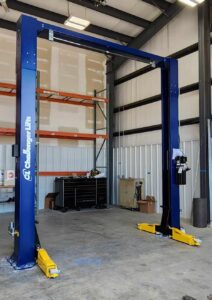What keeps a 2-post car lift from tipping over?
When it comes to the safety and stability of a 2-post car lift, several key factors come into play to prevent tipping over and ensure the security of the vehicle and the operator. Here’s a breakdown of the essential elements that contribute to the stability of a 2-post car lift.
Concrete Anchors
The lift is secured to the floor using concrete anchors, which play a crucial role in preventing the lift from tipping over. The base plate thickness, concrete strength, and anchor bolt strength are all significant factors in maintaining the stability of the two-post lift.
Restraint Devices
High-quality two-post car lifts employ restraint devices, such as gear mechanisms, to prevent the arms from shifting or dislodging. These safety features are essential for ensuring the stability of the lift, particularly when a vehicle is mounted and raised. The automatic gear arm restraints disengage only when the lift is in a safe, lowered state, adding an extra layer of security.
Support Pad Slippage
An analysis of vehicle stability when using two-post above-ground automotive lifts highlighted the importance of factors such as support pad type and condition in preventing slippage, which is critical for maintaining the stability of the lift and the vehicle.
Maintenance
Regular maintenance is key to keeping the lift running safely and ensuring that all safety features are in optimal working condition. This includes checking the condition of support pads, lift points under the vehicle, and the overall integrity of the lift.
In conclusion, the stability of a 2-post car lift is maintained through a combination of secure anchoring, safety features such as restraint devices, and ongoing maintenance to ensure all components are in good working order. By adhering to these safety measures, operators can confidently use 2-post car lifts for vehicle maintenance and repairs while prioritizing the safety of both the vehicle and the individuals involved.

